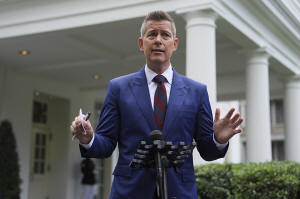Feds vow to overhaul US air traffic control system while fixing problems
at troubled Newark airport
[May 08, 2025]
By JOSH FUNK
A deadly midair collision in January between a military helicopter and a
commercial airliner, several additional crashes and technical problems
that resulted in mass cancellations at New Jersey's biggest airport have
prompted officials to pledge a fix for the nation’s outdated air traffic
control system and vow to hire more controllers.
Doing so, they say, would help ensure safety and prevent the kind of
problems that have plagued the Newark, New Jersey, airport since its
radar system briefly failed last week.
Transportation Secretary Sean Duffy plans to unveil a
multi-billion-dollar plan to overhaul the nation’s air traffic control
system Thursday, while the Federal Aviation Administration works to
quickly solve technology and staffing problems in Newark and avoid
similar crisis elsewhere.
Amid turmoil, one thing seems clear: An aging system struggles to handle
the nation’s more than 45,000 daily flights.
It’s uncertain whether Duffy’s plan that President Donald Trump supports
will get the necessary congressional funding to be more effective than
previous reform efforts during the last three decades. But Duffy says
it's necessary. Already more than $14 billion has been invested in
upgrades since 2003 but none have dramatically changed how the system
works.

“We are on it. We are going to fix it. We are going to build a brand new
system for all of you and your families and the American people,” Duffy
said.
But details are scant. It's unclear whether the plan will involve
privatizing the air traffic control system as Trump backed in his first
term. Duffy has not highlighted that possibility. Thursday's
announcement is expected to attract dozens of unions, which would likely
oppose privatization, along with trade groups, industry representatives
and family members of victims of the January crash.
History of problems
For years, the system has operated well enough to be largely neglected
by every administration, said University of Illinois professor Sheldon
Jacobson, who has studied risks in aviation. “But well enough isn’t good
enough when it comes to air travel because people’s lives are at risk.”
Jacobson is skeptical Duffy's proposal will succeed. But there could be
renewed support following the collision between an American Airlines jet
and an Army helicopter over Washington D.C. in January, and a plane that
flipped and caught fire in Toronto.
The weaknesses of the nation's air traffic control system have for years
been highlighted in reports and hearings. Most recently, a Government
Accountability Office review released in March declared that 51 of the
FAA's 138 systems were considered unsustainable and another 54 were
potentially unsustainable. A 2023 outage in FAA's Notice to Airmen
system forced the grounding of every flight nationwide for more than two
hours.
“We’re dealing with an outmoded system and we have an outdated
infrastructure,” said former Continental Airlines CEO Frank Lorenzo, who
helped establish a major hub in Newark that United Airlines still
maintains years after acquiring Continental. “We haven’t really given it
the attention that it requires.”
Outdated technology
The president of National Air Traffic Controllers Association told
Congress that the majority of the FAA's telecommunications
infrastructure at more than 4,600 sites relies at least in part on aging
copper wires, instead of more reliable fiber optic lines that can handle
more data. Unexpected outages related to those lines routinely cause
ground stops at airports and appear to have led to the problems in
Newark.

[to top of second column]
|

Transportation Secretary Sean Duffy speaks to the media at the White
House, Tuesday, May 6, 2025, in Washington. (AP Photo/Evan Vucci,
File)

The radar system air traffic controllers in Philadelphia use to
direct planes in and out of the Newark airport went offline for at
least 30 seconds on April 28. That facility relies on radar data
sent over lines from New York that may have failed, some of which
are old copper phone lines. The FAA relies on those lines because
Newark controllers were moved from New York to Philadelphia last
summer to address staffing issues.
The FAA said Wednesday it plans to replace any old copper wires with
fiber optics and add three new data lines between New York and
Philadelphia. The agency is also working to get additional
controllers trained and certified.
It wasn’t immediately clear how long either step will take, but
Duffy has said he hopes the situation in Newark will improve by
summer, which is when an ongoing runway construction project is
scheduled for completion. Several controllers remain on extended
trauma leave after the radar outage, which worsened staff shortages
in Philadelphia.
In response, the FAA has slowed traffic in and out of Newark to
ensure flights can be handled safely, leading to cancellations.
Duffy also said FAA will meet with all airlines to determine how
many flights the airport can handle. On Wednesday, Newark led the
nation with 42 canceled departures and 46 canceled arrivals,
according to FlightAware.com. That’s even after United cut 35 daily
flights at the airport starting last weekend.
Some upgrades have been completed
The FAA has made incremental improvements as part of its Nextgen
program that was established in 2003. Advancements include
development of the ADS-B system that provides more precise aircraft
locations to controllers and other planes. That system has been a
focal point of the investigation of the January crash because the
Black Hawk helicopter was not using it to broadcast its location at
the time of the collision.

Duffy has also tried to supercharge air traffic controller hiring by
shortening the time it takes to get into the academy and improving
student success rates. The FAA is also offering bonuses to
experienced controllers to discourage early retirement.
A major challenge to upgrading the aviation infrastructure is that
the FAA must keep the current system operating while developing a
new system — and then find a way to seamlessly switch over. That's
partly why the agency has pursued more gradual improvements in the
past.
"The problem has existed for decades. It’s not because of neglect,
but because it’s a hard problem to solve," said Jeff Guzetti, who is
a former accident investigator who also worked in the Transportation
Department's Inspector General's office for several years that was
focused on aviation. “And it requires money and good management. And
the FAA has been has had shortages of both money and in some cases
good management for years.”
All contents © copyright 2025 Associated Press. All rights reserved |